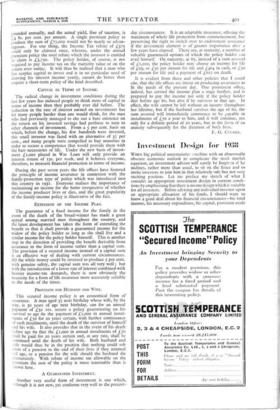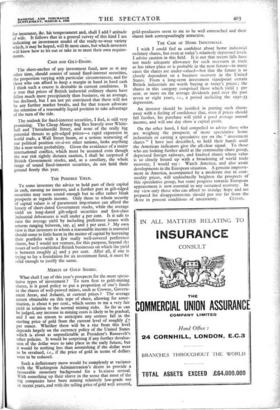Investment Design for 1938
WHEN big political uncertainties 'Lon:bine with an abnormally obscure economic outlook to complicate the stock market equation, an investment adviser will surely be forgiven if he inclines, rather more than usual, to sit on the fence and to invite investors to join him in that relatively safe but not very exciting position. Let me preface my sketch of what I consider an appropriate investment design in current condi- tions by emphasising that there is no one design which is suitable for all investors. Before advising any individual investor upon an appropriate allocation of his funds, I should want to know a good deal about his financial circumstances—his total income, his necessary expenditure, his capital, provision made for insurance, &c. his-temperament and, shall I add ? attitude of wife. It follows that in a general survey of this kind I am indicating an investment model of the ready-to-wear variety which, it may be hoped, will fit most cases, but which investors will know how to let out or take in to meet their own require- ments.
CASH AND GILT-EDGED.
The sheet-anchor of any investment fund, now as at any other time, should consist of sound fixed-interest securities, the proportion varying with particular circumstances, and for those who can afford to keep a margin in hand in hard cash I think such a course is desirable in current conditions. It is true that prices of British industrial ordinary shares have fallen much more precipitately than business, on an average, has declined, but I am not yet convinced that there will not be any further market breaks, and for that reason advocate the retention of a reasonably liquid position to take advantage of the turn of the tide.
The outlook for fixed-interest securities, I feel, is still very promising. The Cheap Money flag flies bravely over White- hall and Threadneedle Street, and none of the really big potential threats to gilt-edged prices—a rapid expansion in world trade, a Wall Street boom, or a serious worsening of our political position vis-a-vis other nations, looks anything like a near-term probability. Given the avoidance of a major international conflict, which must be assumed even though the war risk rightly dictates caution, I shall be surprised if British Government stocks, and, as a corollary, the whole range of sound fixed-interest securities, do not hold their ground firmly this year.
THE POSSIBLE YIELD.
To some investors the advice to hold part of their capital in cash, earning no interest, and a further part in gilt-edged securities may seem sound enough but to offer rather bleak prospects as regards income. Only those to whom security of capital values is of paramount importance can afford the luxury of short-dated Government stocks, while the average yield on long-dated gilt-edged securities and first-class industrial debentures is well under 4 per cent. Is it safe to raise the average -yield by including preference issues with returns ranging between, say, 41 and 5 per cent. ? My own view is that investors to whom a reasonable income is essential should come to little harm ill the matter of capital by leavening their portfolio with a few really well-covered preference shares, but I would not venture, for this purpose, beyond the issues of well-established British businesses on which the yield is between roughly 4f and 5 per cent. After all, if one is trying to lay a foundation for an investment fund, it must be solid enough to justify the name.
MERITS OF GOLD SHARES.
What shall I say of this year's prospects for the more specu- lative types of investment ? To turn first to gold-mining shares, is it good policy to put a proportion of one's funds in the shares of well-proved mines, such as Crowns, Govern- ment Areas, and Ashanti, at current prices ? The average return obtainable on this type of share, allowing for amor- tisation, is about 6 per cent., which seems to me a very fair yield in relation to the normal mining risks. So far as can be judged, any increase in mining costs is likely to be gradual, and I see no reason to anticipate any serious fall in the sterling price of gold from the current level of roughly L7 per ounce. Whether there will be a rise from this level depends largely on the currency policy of the United States which is about as unpredictable as President's Roosevelt's other policies. It would be surprising if any further devalua- tion of the dollar were to take place in the early future, but it would be nothing less than astonishing if the dollar were to be revalued, i.e., if the price of gold in terms of dollars were to be reduced.
Such a deflationary move would be completely at variance with the Washington Administration's desire to provide a favourable monetary background for a business revival. With something up their sleeve in the sense that most of the big companies have been mining relatively low-grade ore in recent years, and with the selling price of gold well assured, gold-producers seem to me to be well entrenched and their shares look correspondingly attractive.
THE CASE OF HOME INDUSTRIALS.
I wish I could feel as confident about home industrial ordinary shares, but even at today's relatively depressed levels I advise caution in this field. It is not that recent falls have not made adequate allowance for such recession in trade as has taken place or is probable in the near future—in many cases the shares are under-valued—but that the future is so closely dependent on a business recovery in the United States. From a long-term investment standpoint certain British industrials are worth buying at today's prices ; the shares in this category comprised those which yield 5 per cent. or more on the average dividends paid over the past seven or eight years, i.e., a period including the 193o-33 depression.
An investor should be justified in putting such shares away with a feeling of confidence that, even if prices should fall further, his purchase will yield a good average annual income, and will one day show a capital profit.
On the other hand, I feel compelled to advise those who are weighing the prospects of more speculative home industrials or casting a speculative eye on the " investment shares " I have just described, to hold their hands until the American indicators give the all-clear signal. To those who are looking further afield at the commodity-share group, depressed foreign railways, and kindred shares whose value is so closely bound up with a broadening of world trade recovery, I would say : Watch America, and also await developments in the European situation. A genuine improve- ment in America accompanied by a moderate rise in com- modity prices, will undoubtedly brighten the prospects of this speculative group, but some progress towards European appeasement is now essential to any sustained recovery. In my view only those who can afford to indulge hope and are prepared for disappointments should put out far from the shore in present conditions of uncertainty. CUSTOS.







































































 Previous page
Previous page